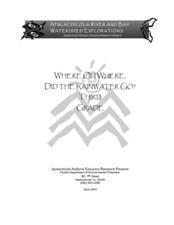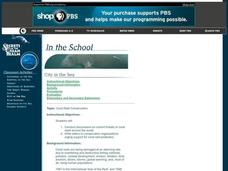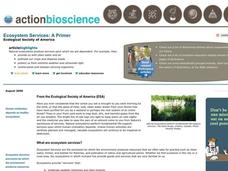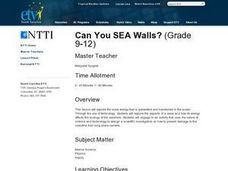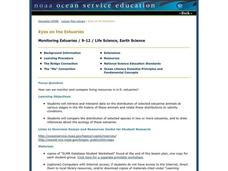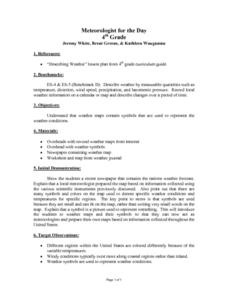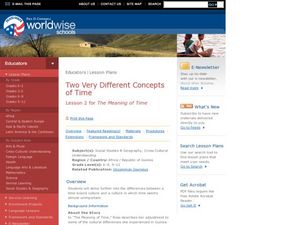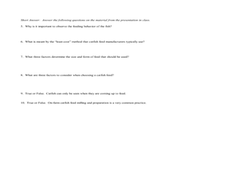Curated OER
To Fish or Not to Fish?
Young scholars demonstrate the decision-making process for marine reserves designations. For this role-playing lesson students analyze maps and data relating to a proposed reserve. They formulate the best decisions based on overall issues.
Curated OER
Where Oh Where Did the Rainwater Go?
Third graders conduct an experiment to determine how water moves through different soils found in the Apalachicola River watershed. They read a scenario, conduct the experiment, answer follow-up questions, and draw the water movement...
Curated OER
Coral Reef Conservation
High schoolers conduct discussions on current threats to coral reefs around the world and write letters to conservation organizations urging support for coral reef protection.
Curated OER
Weather Anomalies
Ninth graders participate in a simulation of a select scientific team from the National Oceanic and Atmospheric Administration (NOAA).
Curated OER
How Much Is an Ecosystem Worth?
Students examine the value of ecosystems. They read and analyze an article, evaluate ecosystem services, research the benefits of biomonitors, and design a public service announcement.
Curated OER
Can You SEA Walls?
High schoolers explore how wave energy that is generated and transferred in the ocean. They explore the aspects of a wave and how its energy affects the ecology of the seashore. Students engage in an activity that uses the nature of...
Curated OER
Keeping Watch on Coral Reefs
Students investigate the dangers Coral Reefs face by investigating satellite images. In this environmental protection instructional activity, students utilize the Internet to discover the types of satellites and sensors used to...
Curated OER
An Enemy of the People Quiz
In this online interactive reading comprehension worksheet, learners respond to 15 multiple choice questions about Ibsen's An Enemy of the People. Students may submit their answers to be scored.
Curated OER
Involving Community Members, Parents, and Community Agencies in Student Learning
Students predict and estimate the number of moose shot by people between the years of 1986-1990. They analyze data and statistics, construct bar graphs, and conduct research on the Alaskan moose.
Curated OER
Sharkland Wiki
Students, while researching the waters around southern Africa and viewing a video of the episode "Sharkland" from Thirteen's series NATURE, critique reliability of online resources and analyze the various components of a wiki. They...
Curated OER
Using SWMP Data
Students are introduced to the SWMP system which tracks short-and long-term changes in water. Using this data, they plot and interpret the data on a graph to determine how human activities are lowering the water quality. They also...
Curated OER
See That Sound?
Students study sonar and will explain the concept of it and its major components. In this design lesson students build a low-cost sonar system.
Curated OER
Eyes on the Estuaries
Students study estuaries and compare several ones in the U.S. In this estuary activity students interpret data and compare the distribution of different species.
Curated OER
A Monument for Marine Conservation
Pupils explore the Northwestern Hawaiian Islands to discover what's there and pick up clues as to how people have both harmed and helped the native habitats. They study another protected area and see how to balance conservation efforts...
Curated OER
Tidepool Island Biogeography
Students experience and test island biogeography ideas by comparing diversity and abundance of rocky inter-tidal patches. Working, in groups of three, they investigate rocks and creatures found in a tidepool. Lesson plan designed for...
Curated OER
What's Up at the Rim?
Students are sent on a scavenger hunt to find as many plants as they can in nature.
Curated OER
Coral Reef Lesson Plan Caution: Do Not Bleach!
High schoolers explain five ways that coral reefs benefit humans and identify three threats to the reefs. They investigate the phenomenon of "coral bleaching" while examining ways to reduce threats to coral reefs.
Curated OER
Second Star To the Left and Straight On 'Till Morning" - Spreadsheet Driven Exploration of Pacific Asian Geography
Students explore the geography of Pacific Asia. The class is divided into two groups to participate in a role-play activity where they act as European explorers. Students utilize mathematics, spreadsheet and internet technology to make...
Curated OER
Meteorologist for the Day
Fourth graders examine the symbols used on weather maps. They analyze a newspaper weather forecast and identify and discuss the various symbols used on the map. Next, they prepare a weather map for their own city using the symbols...
Curated OER
Two Very Different Concepts of Time
Students delve further into the differences between a time-bound culture and a culture in which time seems almost unimportant. They answer the questions: How do people of different cultures view time differently? What can we learn from...
Curated OER
Total English Advanced: A Question of Comparatives
For this comparatives practice worksheet, students sharpen their grammar skills as they examine 13 sentences and choose the appropriate word from the word bank to finish them. Students write 5 sentences following comparative structures.
Curated OER
Two Very Different Concepts of Time
Students explore the concept of cultural anthropology. In this culture studies instructional activity, students consider the culture of Guinea as they read "The Meaning of Time" by Katherine Ross. Students also discuss the traits of...
Curated OER
Aquaculture Science
Students research the different careers in aquaculture. In this aquaculture lesson students complete activities that include a PowerPoint presentation.
Curated OER
Chewin' in the Chesapeake
Students examine a web page on food webs and select a habitat to research. In this research lesson students identify the organisms found in the food web and present their findings to the class.

